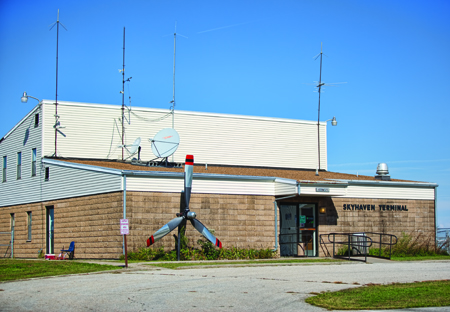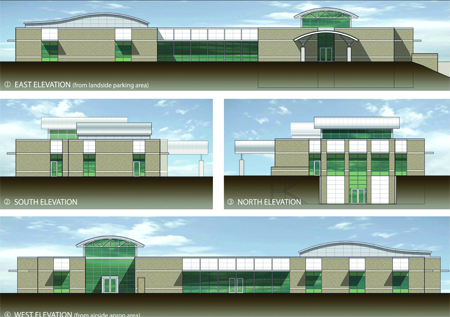
This is the current terminal at the Max B. Swisher Skyhaven Airport. (Photo by ANDREW MATHER, Photo Editor)
Story by ANDY LYONS, News Editor—
During UCM’s first Twitter chat last month, President Chuck Ambrose used the public forum as an opportunity to announce plans for the construction of a new terminal at Max B. Swisher Skyhaven Airport.
In addition to the new terminal, there are also plans for the aviation department to partner with KC Copters, a full service helicopter company and training program founded by Johnny Rowlands, to introduce a rotary/helicopter training program, along with its remote piloted aircraft program.
The aviation department has also formed a partnership with other educational institutions and corporations.
It is working with other agencies to help Missouri be one of the six states to be chosen by the FAA that will be Unmanned Air Vehicle (UAV) training sites nationwide.
There is also a new Memorandum of Understanding in the works with Whiteman Air Force Base to begin offering an Airline Transport Pilot rating.
Skyhaven’s current terminal area, including the aircraft apron, will require relocation to the north of its present location.
The relocation of the terminal area will include the construction of a new terminal building and a parking lot for visitors, multiple hangars, a fuel facility, maintenance hangar and an aircraft-parking apron.

These are the designs for the new terminal, which will be located north of the existing one. (Graphic submitted)
The new terminal is to be reconstructed to accommodate approximately 9,500 square feet of space. The space will meet the needs of both public and academic flight school needs.
The term “terminal building” refers to both an academic facility and a fixed-base operator, or FBO, which is a commercial business granted the right to operate on the airport and provide aeronautical services. It will include the commodities associated with a FBO, as well as provide flight instructor classrooms and training facilities.
There are multiple reasons that a new terminal is needed at Skyhaven.
“The current facilities are outdated and do not meet the needs of the public or academic flight school.
The terminal facility will help boost the transient (public) aircraft numbers needed to justify the runway expansion project, as well as meet the growing demands of the flight school,” said Tony Monetti, assistant dean of aviation and executive director of the airport.
“Construction of the new terminal will also provide the framework for the future expansion of the runway, as the current terminal must be demolished in order to expand the runway.
A new facility will also provide a top of the line training facility.”
The new terminal project is being funded in part by a major gift pledged to the UCM Foundation specifically for this project from the Harmon family.
Lynn and Jackie Harmon, longtime Warrensburg residents, are known for their generosity and support of UCM. Their donations helped create UCM’s Harmon College of Business and Professional Studies, which houses the aviation department.
Ambrose sees the benefits from relationships with people such as the Harmon family.
“The Harmon family have been greater friends of UCM and provide vital support to efforts that draw the community and the university together,” Ambrose said.
He also sees the terminal as an important part of UCM, and that the coming changes are needed to keep it that way.
“The airport is one of those assets that helps set UCM apart from our peers, but is also a tremendous economic development opportunity for the entire community,” Ambrose said. “The airport is really the door to the Warrensburg community as you drive Highway 50 from the metro of Kansas City. The new terminal will also be a significant enhancement for our students, faculty and the general aviation community that travels to Warrensburg via Skyhaven.”
The terminal is part of phase two of the aviation master plan.
According to a UCM news release, the multi-phase expansion of the airport will lengthen the primary runway to accommodate turbojet and light jet aircraft. Phase two also includes filling cracks and sealing all asphalt surfaces.
The result will be a new paint job for the runways and taxiways for aircraft. The plan is to break ground on the new terminal later this year.
Phase one of the 20-year master plan was completed in 2012. It included grading for a new terminal, improvements to the apron and taxiways, new T-hangars and access road, and property acquisition for a safety zone for landing and departing aircraft. Phase two begins with a focus on acquiring external funding for the $3.1 million terminal, parking facilities and relocation of hangar two.
The new programs will help solidify Skyhaven as a major benefit to UCM.
The partnership with KC Copters will allow UCM aviation to offer rotary rating certification. KC Copters is an FAA approved 141 school, which means instructors have met more stringent standards than others. Monetti said that he trusts KC Copters because of their strong culture of safety and professionalism.
“Johnny Rowlands is a man that shares the same values of UCM aviation; he’s passionate about safety,” Monetti said.
Monetti and Rowlands’s team has been working out the details for months now, and an agreement will be signed March 28 at 10:30 a.m. Ambrose will attend the ceremony at Skyhaven.
Eventually, the aviation department plans to have not only fixed-wing and rotary ratings, but eventually to also offer UAV, also known as Remotely Piloted Aircraft (RPA), ratings and degrees.
Monetti recently informed the Aviation Accreditation Board International (AABI) of his intention to have UCM integrate rotary and RPA’s into their curriculum.
“UCM’s aviation program is aggressively positioning itself to provide programs and degrees that are aligned with changes within the industry and expanded opportunities for graduates to be competitive with their UCM degree,” Ambrose said. “The rotary and UAV programs are natural extensions of our growing partnership with WAFB and will help keep our program distinctive into the future.”
Offering an ATP rating, as a result of the new memorandum with WAFB, will help UCM do just that. Monetti said earning an ATP is similar to earning a doctorate degree, in that an ATP is the highest rating possible for pilots to attain. Monetti said he is excited to offer such a rating to pilots nationwide.
A couple months ago, Monetti asked the UCM Board of Governors for their consent to purchase another multi-engine Seminole aircraft in anticipation for this ATP program. A private donor pledged $300,000 to make this possible.
Monetti explained to the Board that 2013 will be known as the year of the pilot. It appears that this is accurate as airlines across the world are experiencing pilot shortages.
Monetti recently attended an AABI conference at Auburn University and many of the major airlines were in attendance, including Delta and United Airlines.
Monetti said that both of the airlines’ senior leadership warned all in attendance that the U.S. would have a significant pilot shortage for at least the next 10 years.
This is welcome news to aviation training schools, and it puts UCM aviation in a great position to help meet that challenge.
For more information about UCM aviation, find the department on Facebook or visit the new website at ucmo.edu/aviation.


Happy to Skyhaven upgrades!
Excellent article………….it explained the expansion of our neighbor (Skyhaven) to Willow Acres residents!